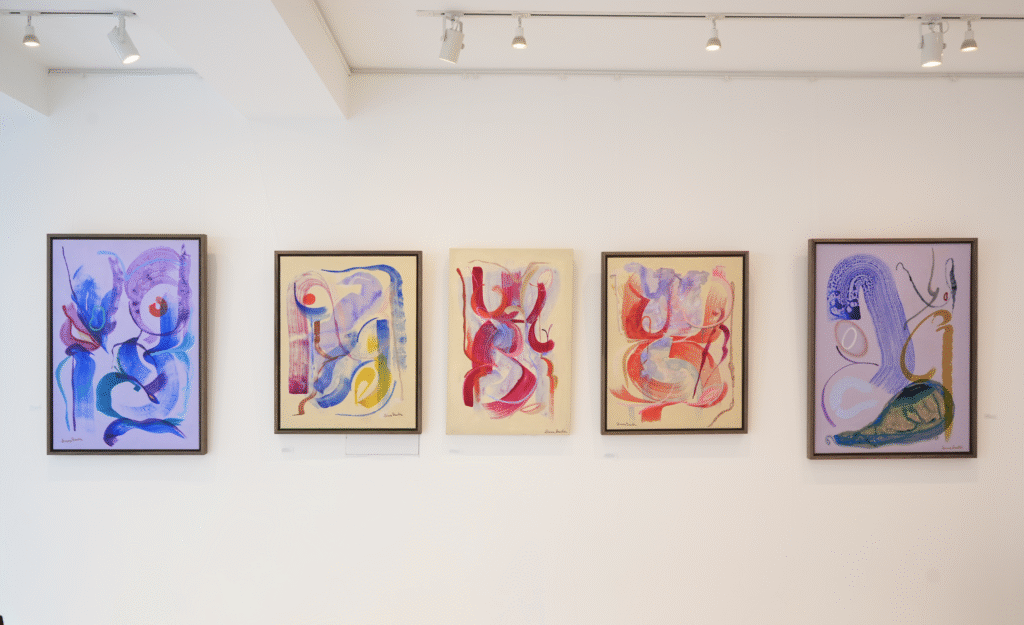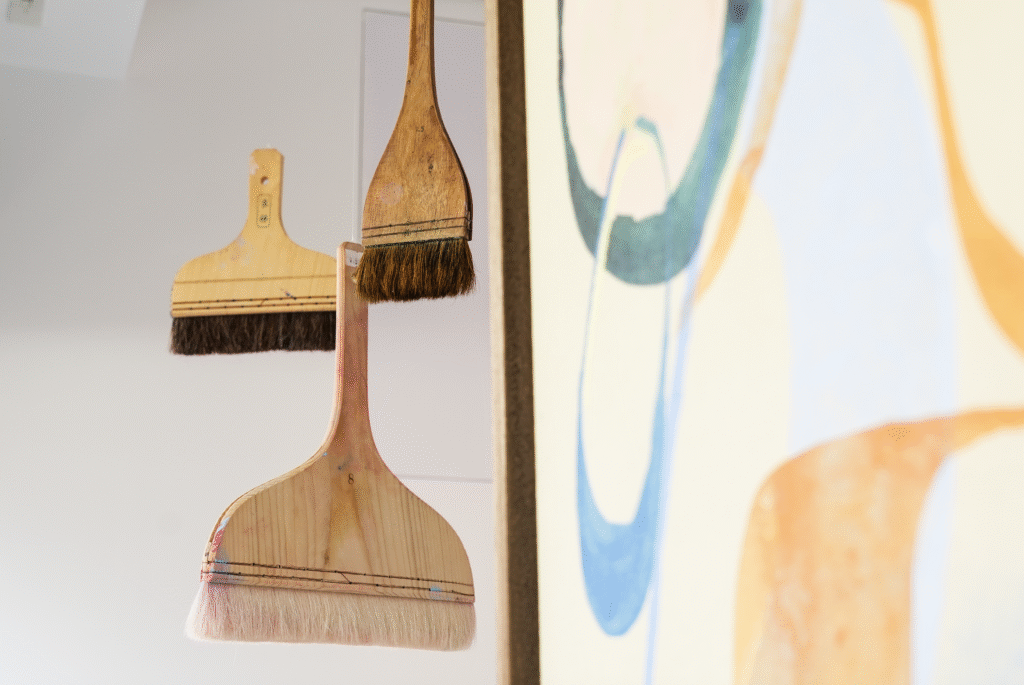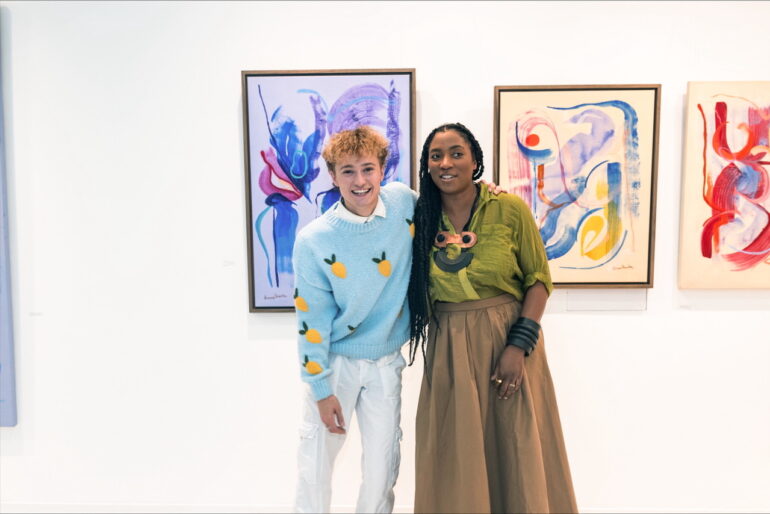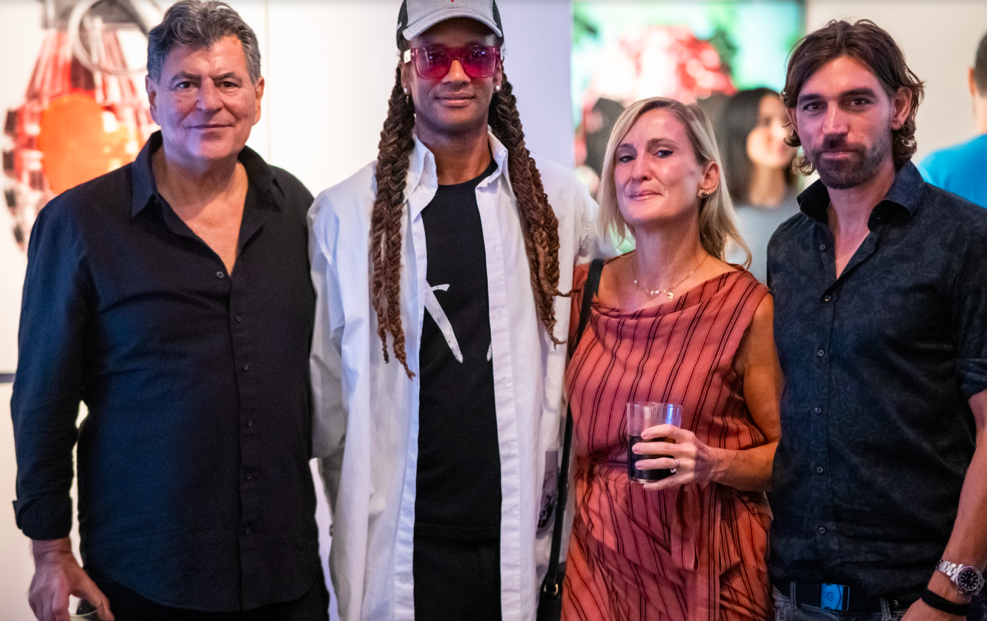Simone Brewster and James Marshall on Embracing the Beauty of ‘Imperfect’ in Notting Hill.
Culturalee spoke to curator James Marshall and artist Simone Brewster about Imperfect–Brewster’s latest solo exhibition at J/M Gallery, Notting Hill.
Running daily until 30th September 2025, the show reframes imperfection not as a flaw but as a generative force: a site of intimacy, confrontation, and ultimately growth. Bringing together Brewster’s practice across painting, jewellery, furniture, and pavilion-making, Imperfect dismantles and reimagines the body as abstract terrain, continuing her exploration of form and identity following last year’s acclaimed Changing Tides.
James Marshall
As curator, how did you approach framing Simone’s practice–which resists categorisation–into the narrative of Imperfect without confining it?
I didn’t want to force her practice into a single definition because Simone herself resists that. Instead, I treated the exhibition as a snapshot in an ongoing journey since 2007. The works in Imperfect belong to the same world as her design, furniture, jewelry and pavilion projects – but they use the medium of paint. I originally tried to approach the painting collection as a singular unit, separate from her other disciplines for the show. It was impossible trying to place them within their own context as the themes work in tandem across disciplines, not in competition or against. For example, we placed Simone’s rug, released commercially with Habitat for their 60th anniversary, alongside the paintings as her design now takes inspiration from her paintings. You can recognise the forms on the rug coming from the paintings, even though Simone was a designer before painting. So there’s very literal examples in the show where you can see this crossover, and how her disciplines continue to work like an ever-growing ecosystem. My role was to create a framework where the audience could see the connections without expecting a fixed label or theme – refusing to place it in an aloof theoretical box.

This exhibition deals with fragmentation, irregularity, and incompleteness. From your curatorial perspective, how do you want audiences in Notting Hill to experience and engage with these ideas?
These ideas aren’t meant to be intimidating. I hope people feel that fragmentation and irregularity are familiar states – part of their own lives. The show invites you to bring your own body and experience into the room, and to recognise that being “imperfect” is part of being human. The themes might sound cliche to some, as of course female forms and opposing beauty standards have been prevalent in art for a long time, but right now we’re in an ever-worrying time when it comes to accepting our image. We might think we’ve gotten over the toxicity of the 00s and early 10s – but drugs such as Ozempic have overshadowed the toxicities of body-conformation and placed the power that diet cultures previously held, into the hands of its user. We’re witnessing a silent form of diet culture happen in its biggest boom yet. The shapes and forms in Simone’s work aren’t necessarily obvious depictions of the body, although extremely familiar. Taking a similarly silent/subtle approach to depicting the body, placing these large, ghastly and sometimes uncomfortable shapes in presented and polished arrangements acts as a gentle comforter, as opposed to a ‘look-in-the-mirror’, self-critical view.
You’ve described imperfection as a site of intimacy and growth. How do you see Simone’s exhibition contributing to broader conversations around body, identity, and cultural memory in contemporary art today?
As the case for many years, there’s yet a constant pressure today to present the body as polished or perfected. Everything is ‘perfect’, and we’re told to love ourselves. But sometimes we don’t, and trying to gain a relationship with those shapes and growths that feel intimidating is a natural reaction. Instead of saying we’re all perfect and lovely, why not admit that we can be imperfect, annoying and frustrating? Simone’s work embraces that. Simone’s work reminds us that imperfection is where true intimacy and real identity live.
To find out more about James Marshall visit: https://www.theinventive.co.uk
Simone Brewster
In Imperfect, you describe searching for a “perfect imperfect.” How do you see imperfection not as a flaw, but as a source of strength and beauty in both your work and in how we perceive the body?
The first strength I see when embracing imperfection is the power of acceptance, and the potential that can open up to us as people and especially as creative people. When creating with an intention it’s easy to have a nervous energy as you want to control the outcome as much as possible, but exploration and embracing the happy accidents can often lead to me learning more and creating something far more insightful than I would have, if I fought the natural process and didn’t incorporate the natural progression of the piece.
When I’ve applied this thinking to myself and my body, it’s been a bit of a balm. After having my son, there were so many changes in my body that it didn’t feel like home anymore; but then I actually spent time looking at the changes and thinking about why the new marks and shapes were there. My body wasn’t “perfect” anymore, but it was definitely something I was impressed by and connected to in a different way. Put simply, it made sense for who I was and where I was at that moment.

Your practice spans jewellery, furniture, large-scale pavilions, and now painting. What does painting, particularly collage and abstraction allow you to express that other mediums cannot?
Painting has a freedom that isn’t available in other parts of my practice. What I’ve found most refreshing is the role that art plays in society, making conversations around the subjects that arise more prominent and open. Topics that are more unusual or difficult to express in other mediums are rich and central when painting. The use of collage is almost a translation from my wider practice. A particular piece, The Negress, which is a seating element, uses simplified, reconfigured parts of the female form to act as the supporting elements of the seat. That collaged approach has been something I’ve wanted to play with in a more direct way when painting and I’ve finally taken the opportunity to do so. It’s a very fresh chapter and I feel like it expands the dialogue between my three dimensional practice and my painting.
The Three Sisters is such a personal centrepiece of this exhibition. How did translating your relationship with your sisters into abstract form shift your understanding of intimacy and identity in your work?
I’ve been building up to this point in my practice, and the paintings definitely feel like an inflection point. I’ve wanted to do a series of paintings about my sisters for some time, but haven’t necessarily had the confidence on canvas to begin translating and expressing these women who I know so closely. In the end, I think it went back to embracing the imperfection and just allowing myself the opportunity to begin exploring the subject matter without worrying about how the pieces would be received. This allowed me to begin expressing some shifts I’ve been holding back on, like working with a black canvas and collaging on material for texture and depth. Over the years I’ve also worked on a language of symbols that I reflect on when generating a piece, for these paintings, new forms and languages have entered. It really feels like the start of something, and the return to something more rooted and deeper. It’s exciting.
To find out more about Simone Brewster visit: https://www.simonebrewster.co.uk



